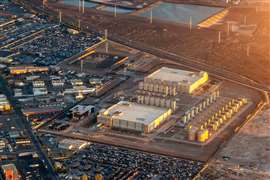Three-month high in Irish market
14 May 2018

A three-month high across the Irish construction sector has been reported, as activity continued to increase in April, according to the Ulster Bank Construction Purchasing Managers’ Index (PMI).
It said that greater output had also reflected in faster growth in new orders, input purchasing and employment, although rises in demand were found to have led to increased pressure on supply chains and a marked increase in input prices.
Although the market was described as “robust overall”, confidence at construction firms was said to have dipped to a three-month low.
The Ulster Bank Construction PMI – a seasonally adjusted index designed to track changes in total construction activity – rose from 57.5 in March to 60.7 in April. It said the latest reading had signalled a sharp expansion across the Irish construction sector, and was the second-fastest since May 2017. The overall upturn was driven by an increase in new projects following the poor weather in the first few months of the year.
Simon Barry, chief economist Republic of Ireland at Ulster Bank, said, “The latest results of the Ulster Bank Construction PMI survey show that Irish construction firms experienced strong, and faster, rates of expansion in April.
“There was a very sharp acceleration in commercial activity which took the commercial PMI to its highest level since last May, in the process leaving commercial as the strongest performing activity category last month.”
However, he said the improvement was broadly-based, with the pace of growth in housing activity also picking up to an 11-month high, while civil engineering recorded a fifth consecutive month of expansion, albeit at a somewhat slower pace in April.
“Respondents also reported a marked pick-up in new business flows reflecting stronger client demand,” said Barry, “with the new orders index rising to a very elevated reading – and nine-month high – of 61.6 in April.
“And the buoyancy in activity and new orders continues to underpin very strong and accelerated rates of job creation, with the employment index picking up last month to its highest level since early 2017.”
He said that sentiment among firms about the sector’s prospects over the coming 12 months had moderated slightly in April, but remained at elevated levels.
A figure of 58% of respondents forecast higher output levels over the year ahead, reflecting expectations for healthy construction demand in general, and within the residential sector in particular, he added.
The PMI showed that total activity growth had been supported by sharper rises in housing and commercial activity, each of which reported marked increases that were the fastest in 11 months.
Meanwhile, growth in civil engineering activity was seen to have softened, and was the weakest of the three monitored sub-sectors.
New orders
The PMI revealed that new orders received had increased at a marked pace in April. Greater client demand and wider success in tender applications were largely linked to the latest rise in new business, and the rate of expansion was the quickest in nine months.
Greater global demand for construction inputs placed pressure on supply chains, with vendor performance deteriorating further in April, it found. Strains on capacities reportedly led to many suppliers increasing their prices.
Ulster Bank said that anecdotal evidence had suggested that the marked rise in cost burdens was a result of higher raw material prices, especially steel and insulation.
It said that business confidence concerning output over the coming 12 months had been robust in April. Although dipping to a three-month low, widespread optimism stemmed from increased client demand and greater requests for housebuilding.




